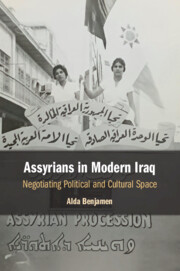Book contents
- Assyrians in Modern Iraq
- Assyrians in Modern Iraq
- Copyright page
- Dedication
- Contents
- Figures
- Preface
- Acknowledgments
- Note on Transliteration
- Abbreviations
- Introduction
- 1 Assyrians and the Iraqi Communist Party
- 2 The Role of Assyrians and Communists in the Kurdish Uprising (1961–1975)
- 3 Between Reconciliation and Repression
- 4 Compliance, Negotiation, Resistance
- 5 The Reestablishment of the Assyrian Nationalist Political Movement (1970s–1980s)
- Conclusion
- Book part
- Select Bibliography
- Index
4 - Compliance, Negotiation, Resistance
Assyrian Press and Popular Culture (1970s–1980s)
Published online by Cambridge University Press: 20 January 2022
- Assyrians in Modern Iraq
- Assyrians in Modern Iraq
- Copyright page
- Dedication
- Contents
- Figures
- Preface
- Acknowledgments
- Note on Transliteration
- Abbreviations
- Introduction
- 1 Assyrians and the Iraqi Communist Party
- 2 The Role of Assyrians and Communists in the Kurdish Uprising (1961–1975)
- 3 Between Reconciliation and Repression
- 4 Compliance, Negotiation, Resistance
- 5 The Reestablishment of the Assyrian Nationalist Political Movement (1970s–1980s)
- Conclusion
- Book part
- Select Bibliography
- Index
Summary
Chapter 4 highlights the ways in which urban Assyrian intellectuals took advantage of Law 251 in their dealings with the state. In their magazines and clubs, they used accepted narratives to argue for greater cultural, political, and administrative rights. This campaign was pursued subtly in the press, but more vocally in popular culture. Assyrian intellectuals and singers also engaged with Arab and Kurdish intellectuals, contributing to a hybridized Iraqi sphere that cut across sectarian and ethnic divides, contributing to Assyrian intellectual discourses that extended far beyond Iraq’s borders.
- Type
- Chapter
- Information
- Assyrians in Modern IraqNegotiating Political and Cultural Space, pp. 143 - 186Publisher: Cambridge University PressPrint publication year: 2022

